Rebar
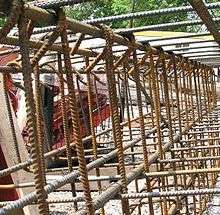
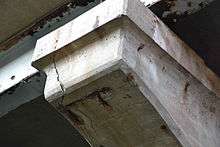
Rebar (short for reinforcing bar), also known as reinforcing steel, reinforcement steel[1] and colloquially in Australia as reo, is a steel bar or mesh of steel wires used as a tension device in reinforced concrete and reinforced masonry structures to strengthen and hold the concrete in tension. Rebar's surface is often patterned to form a better bond with the concrete.
History

Originally, concrete structures were unreinforced. Rebar has been used in construction since at least the 15th century; for example, 2500 m of rebars were used in the Château de Vincennes.[2]
More recently, during the 18th century, rebar was used to form the carcass of the Leaning Tower of Nevyansk in Russia, built on the orders of the industrialist Akinfiy Demidov. The cast iron used for the rebar was of high quality, and there is no corrosion on them to this day. The carcass of the tower was connected to its cast iron tented roof, crowned with one of the first known lightning rods.[3] More recently these techniques have been refined by embedding the steel bars in the concrete, and by the introduction of deformed bars to improve bonding, thus producing modern reinforced concrete.
Use in concrete and masonry
Concrete is a material that is very strong in compression, but relatively weak in tension. To compensate for this imbalance in concrete's behavior, rebar is cast into it to carry the tensile loads. Most steel reinforcement is divided into primary and secondary reinforcement, but there are other minor uses:
- Primary reinforcement refers to the steel which is employed to guarantee the resistance needed by the structure as a whole to support the design loads.
- Secondary reinforcement, also known as distribution or thermal reinforcement, is employed for durability and aesthetic reasons, by providing enough localized resistance to limit cracking and resist stresses caused by effects such as temperature changes and shrinkage.
- Rebar is also employed to confer resistance to concentrated loads by providing enough localized resistance and stiffness for a load to spread through a wider area.
- Rebar may also be used to hold other steel bars in the correct position to accommodate their loads.
- External steel tie bars can constrain and reinforce masonry structures, as illustrated by the Nevyansk Tower or ancient structures in Rome and the Vatican.
Masonry structures and the mortar holding them together have similar properties to concrete and also have a limited ability to carry tensile loads. Some standard masonry units like blocks and bricks are made with voids to accommodate rebar, which is then secured in place with grout. This combination is known as reinforced masonry.
While any material with sufficient tensile strength could potentially be used to reinforce concrete (glass and basalt fibers are also common), steel and concrete have similar coefficients of thermal expansion:[4] a concrete structural member reinforced with steel will experience minimal stress as a result of differential expansions of the two interconnected materials caused by temperature changes.
Physical characteristics
Steel has an expansion coefficient nearly equal to that of modern concrete. If this were not so, it would cause problems through additional longitudinal and perpendicular stresses at temperatures different from the temperature of the setting.[5] Although rebar has ribs that bind it mechanically to the concrete, it can still be pulled out of the concrete under high stresses, an occurrence that often accompanies a larger-scale collapse of the structure. To prevent such a failure, rebar is either deeply embedded into adjacent structural members (40-60 times the diameter), or bent and hooked at the ends to lock it around the concrete and other rebar. This first approach increases the friction locking the bar into place, while the second makes use of the high compressive strength of concrete.
Common rebar is made of unfinished tempered steel, making it susceptible to rusting. Normally the concrete cover is able to provide a pH value higher than 12 avoiding the corrosion reaction. Too little concrete cover can compromise this guard through carbonation from the surface, and salt penetration. Too much concrete cover can cause bigger crack widths which also compromises the local guard. As rust takes up greater volume than the steel from which it was formed, it causes severe internal pressure on the surrounding concrete, leading to cracking, spalling, and ultimately, structural failure. This phenomenon is known as oxide jacking. This is a particular problem where the concrete is exposed to salt water, as in bridges where salt is applied to roadways in winter, or in marine applications. Uncoated, corrosion-resistant low carbon/chromium (microcomposite), epoxy-coated, galvanized or stainless steel rebars may be employed in these situations at greater initial expense, but significantly lower expense over the service life of the project. Extra care is taken during the transport, fabrication, handling, installation, and concrete placement process when working with epoxy-coated rebar, because damage will reduce the long-term corrosion resistance of these bars.[6] Even damaged bars have shown better performance than uncoated reinforcing bars, though issues from debonding of the epoxy coating from the bars and corrosion under the epoxy film have been reported.[7] These bars are used in over 70,000 bridge decks in the USA.[8]
Fiber-reinforced polymer rebar is also used in high-corrosion environments. It is available in many forms, such as spirals for reinforcing columns, common rods, and meshes. Most commercially available rebar is made from unidirectional glass fibre reinforced thermoset resins.
Reinforcing steel can also be displaced by impacts such as earthquakes, resulting in structural failure. The prime example of this is the collapse of the Cypress Street Viaduct in Oakland, California as a result of the 1989 Loma Prieta earthquake, causing 42 fatalities. The shaking of the earthquake caused rebars to burst from the concrete and buckle. Updated building designs, including more circumferential rebar, can address this type of failure.
Sizes and grades
US sizes
Imperial bar sizes give the diameter in units of ⅛ inch, so that #8 = 8⁄8 inch = 1 inch diameter. The cross sectional area, as given by πr², works out to (bar size/9.027)², which is approximated as (bar size/9)² square inches. For example, the area of #8 bar is (8/9)² = 0.79 square inches.
Larger bar sizes are based on the cross-sectional area of square bars that were formerly used. The diameter of the equivalent round shapes is rounded to the nearest ⅛ inch to provide the bar size. For example, #9 bar has a cross section of 1.00 square inches, and therefore a diameter of 1.128 inches. #10, #11, #14, and #18 sizes correspond to 11⁄8 inch, 11⁄4, 11⁄2, and 2 inch square bars, respectively.[9] #14 rebar is particularly affected by this approximation; by diameter it would be #13.5.
The tower and sign industries commonly use slightly larger "jumbo" bars #14J and #18J as anchor rods for large structures.[10] The bars are fabricated from slightly oversized blanks such that threads can be cut at the ends to accept standard 1.75" (#14J) and 2.25" (#18J) anchor nuts.
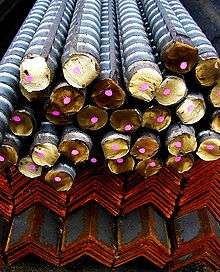
| Imperial
bar size |
Metric size | Linear Mass Density | Nominal diameter | Nominal area | |||
|---|---|---|---|---|---|---|---|
| lb⁄ft | (kg/m) | (in) | (mm) | (in²) | (mm²) | ||
| #2 | #6 | 0.167 | 0.249 | 0.250 = 1⁄4 | 6.35 | 0.05 | 32 |
| #3 | #10 | 0.376 | 0.561 | 0.375 = 3⁄8 | 9.525 | 0.11 | 71 |
| #4 | #13 | 0.668 | 0.996 | 0.500 = 1⁄2 | 12.7 | 0.20 | 129 |
| #5 | #16 | 1.043 | 1.556 | 0.625 = 5⁄8 | 15.875 | 0.31 | 200 |
| #6 | #19 | 1.502 | 2.24 | 0.750 = 3⁄4 | 19.05 | 0.44 | 284 |
| #7 | #22 | 2.044 | 3.049 | 0.875 = 7⁄8 | 22.225 | 0.60 | 387 |
| #8 | #25 | 2.670 | 3.982 | 1.000 | 25.4 | 0.79 | 509 |
| #9 | #29 | 3.400 | 5.071 | 1.128 | 28.65 | 1.00 | 645 |
| #10 | #32 | 4.303 | 6.418 | 1.270 | 32.26 | 1.27 | 819 |
| #11 | #36 | 5.313 | 7.924 | 1.410 | 35.81 | 1.56 | 1006 |
| #14 | #43 | 7.650 | 11.41 | 1.693 | 43 | 2.25 | 1452 |
| #18 | #57 | 13.60 | 20.284 | 2.257 | 57.3 | 4.00 | 2581 |
| #18J | 14.60 | 21.775 | 2.337 | 59.4 | 4.29 | 2678 | |
Canadian sizes
Metric bar designations represent the nominal bar diameter in millimeters, rounded to the nearest 5 mm.
| Metric
bar size |
Linear Mass Density
(kg/m) |
Nominal diameter
(mm) |
Cross-sectional
Area (mm²) |
|---|---|---|---|
| 10M | 0.785 | 11.3 | 100 |
| 15M | 1.570 | 16.0 | 200 |
| 20M | 2.355 | 19.5 | 300 |
| 25M | 3.925 | 25.2 | 500 |
| 30M | 5.495 | 29.9 | 700 |
| 35M | 7.850 | 35.7 | 1000 |
| 45M | 11.775 | 43.7 | 1500 |
| 55M | 19.625 | 56.4 | 2500 |
European sizes
Metric bar designations represent the nominal bar diameter in millimetres. Preferred bar sizes in Europe are specified to comply with Table 6 of the standard EN 10080,[11] although various national standards still remain in force (e.g. BS 4449 in the United Kingdom). In Switzerland some sizes are different from European standard.
.jpg)
| Metric
bar size |
Linear Mass Density
(kg/m) |
Nominal diameter
(mm) |
Cross-sectional
Area (mm²) |
|---|---|---|---|
| 6,0 | 0.222 | 6 | 28.3 |
| 8,0 | 0.395 | 8 | 50.3 |
| 10,0 | 0.617 | 10 | 78.5 |
| 12,0 | 0.888 | 12 | 113 |
| 14,0 | 1.21 | 14 | 154 |
| 16,0 | 1.58 | 16 | 201 |
| 20,0 | 2.47 | 20 | 314 |
| 25,0 | 3.85 | 25 | 491 |
| 28,0 | 4.83 | 28 | 616 |
| 32,0 | 6.31 | 32 | 804 |
| 40,0 | 9.86 | 40 | 1257 |
| 50,0 | 15.4 | 50 | 1963 |
Australian sizes
Reinforcement for use in concrete construction is subject to the requirements of Australian Standards AS3600-2009 (Concrete Structures) and AS/NZS4671-2001 (Steel Reinforcing for Concrete). There are other standards that apply to testing, welding and galvanising. The designation of reinforcement is defined in AS/NZS4671-2001 using the following formats:
Bars
| Shape code | Yield strength (MPa) | Ductility class | Nominal diameter (mm) |
| D - deformed bar - Grade 300 | 300 MPa | N - normal | 10 |
| D - deformed bar - Grade 500 | 500 MPa | N - normal | 10 |
| R - round bar | 250 MPa | L - low | 12 |
| 16 | |||
| 20 | |||
| 24 | |||
| 28 | |||
| 32 | |||
| 36 | |||
| 40 |
- Examples:
- D500N12 is deformed bar, 500 MPa strength, normal ductility and 12 mm nominal diameter - also known as "N12"
- R250N20 is round bar, 250 MPa strength, normal ductility and 20 mm nominal diameter - also known as "R20"
Bars are typically abbreviated to simply 'N' (hot-rolled deformed bar), 'R' (hot-rolled round bar), 'RW' (cold-drawn ribbed wire) or 'W' (cold-drawn round wire), as the yield strength and ductility class can be implied from the shape. For example, all commercially available wire has a yield strength of 500 MPa and low ductility, while round bars are 250 MPa and normal ductility.
India
Rebars are available in the Following Grades as per IS:1786-2008 FE 415/500/500D. Rebars are quenched with water at a high level pressure so that the outer surface is hardened and the inner core remains soft.Rebars are Ribbed so that the concrete can have a better grip.Costal regions used Galvanized rebars this prolongs the life of Rebars.
Mesh
| Shape code | Ductility class | Nominal diameter (mm) | Nominal spacing (long direction) | Nominal spacing (short direction) (only required in rectangular mesh) |
| S - square | L - low ductility | 7 mm | 1 – 100 mm | 1 – 100 mm |
| R - rectangular | 8 mm | 2 – 200 mm | 2 – 200 mm | |
| 10 mm | 8 – 80 mm | 8 – 80 mm | ||
| 12 mm |
Grades
Rebar is available in grades and specifications that vary in yield strength, ultimate tensile strength, chemical composition, and percentage of elongation.
In US use, the grade designation is equal to the minimum yield strength of the bar in ksi (1000 psi) for example grade 60 rebar has a minimum yield strength of 60 ksi. Rebar is typically manufactured in grades 40, 60, and 75.
In countries that use the metric system, the grade designation is typically the yield strength in megapascals MPa, for example grade 400 (similar to US grade 60).
Common US specifications, published by ACI and ASTM, are:
- American Concrete Institute: "ACI 318-14 Building Code Requirements for Structural Concrete and Commentary", ISBN 978-0-87031-930-3 (2014)
- ASTM A82: Specification for Plain Steel Wire for Concrete Reinforcement
- ASTM A184/A184M: Specification for Fabricated Deformed Steel Bar Mats for Concrete Reinforcement
- ASTM A185: Specification for Welded Plain Steel Wire Fabric for Concrete Reinforcement
- ASTM A496: Specification for Deformed Steel Wire for Concrete Reinforcement
- ASTM A497: Specification for Welded Deformed Steel Wire Fabric for Concrete Reinforcement
- ASTM A615/A615M: Deformed and plain carbon-steel bars for concrete reinforcement
- ASTM A616/A616M: Specification for Rail-Steel Deformed and Plain Bars for Concrete Reinforcement
- ASTM A617/A617M: Specification for Axle-Steel Deformed and Plain Bars for Concrete Reinforcement
- ASTM A706/A706M: Low-alloy steel deformed and plain bars for concrete reinforcement
- ASTM A767/A767M: Specification for Zinc-Coated(Galvanized) Steel Bars for Concrete Reinforcement
- ASTM A775/A775M: Specification for Epoxy-Coated Reinforcing Steel Bars
- ASTM A934/A934M: Specification for Epoxy-Coated Prefabricated Steel Reinforcing Bars
- ASTM A955: Deformed and plain stainless-steel bars for concrete reinforcement
- ASTM A996: Rail-steel and axle-steel deformed bars for concrete reinforcement
- ASTM A1035: Standard Specification for Deformed and Plain, Low-carbon, Chromium, Steel Bars for Concrete Reinforcement
ASTM marking designations are:
- 'S' billet A615
- 'I' rail A616 (superseded by A996 "ASTM A616 / A616M - 96a Standard Specification for Rail Steel Deformed and Plain Bars for Concrete Reinforcement (Withdrawn 1999)". Astm.org. Retrieved 2012-08-24.)
- 'IR' Rail Meeting Supplementary Requirements S1 A616 (superseded by A996 "ASTM A616 / A616M - 96a Standard Specification for Rail Steel Deformed and Plain Bars for Concrete Reinforcement (Withdrawn 1999)". Astm.org. Retrieved 2012-08-24.)
- 'A' Axle A617(superseded by A996 "ASTM A617 / A617M - 96a Standard Specification for Axle Steel Deformed and Plain Bars for Concrete Reinforcement (Withdrawn 1999)". Astm.org. Retrieved 2012-08-24.)
- 'W' Low-alloy — A706
Historically in Europe, rebar is composed of mild steel material with a yield strength of approximately 250 MPa (36 ksi). Modern rebar is composed of high-yield steel, with a yield strength more typically 500 MPa (72.5 ksi). Rebar can be supplied with various grades of ductility. The more ductile steel is capable of absorbing considerably more energy when deformed - a behavior that resists earthquake forces and is used in design. These high yield strength ductile steels are usually produced using the TEMPCORE process,[12] a method of thermomechanical processing. The manufacture of reinforcing steel by re-rolling finished products (e.g. sheets or rails) is not allowed.[13] In contrast to structural steel, rebar steel grades are not harmonized yet across Europe, each country having their own national standards. However some standardization of specification and testing methods exist under EN 10080 and EN ISO 15630:
- BS EN 10080: Steel for the reinforcement of concrete. Weldable reinforcing steel. General. (2005)
- BS 4449: Steel for the reinforcement of concrete. Weldable reinforcing steel. Bar, coil and decoiled product. Specification. (2005/2009)
- BS 4482: Steel wire for the reinforcement of concrete products. Specification (2005)
- BS 4483: Steel fabric for the reinforcement of concrete. Specification (2005)
- BS 6744: Stainless steel bars for the reinforcement of and use in concrete. Requirements and test methods. (2001/2009)
- DIN 488-1: Reinforcing steels - Part 1: Grades, properties, marking (2009)
- DIN 488-2: Reinforcing steels - Part 2: Reinforcing steel bars (2009)
- DIN 488-3: Reinforcing steels - Part 3: Reinforcing steel in coils, steel wire (2009)
- DIN 488-4: Reinforcing steels - Part 4: Welded fabric (2009)
- DIN 488-5: Reinforcing steels - Part 5: Lattice girders (2009)
- DIN 488-6: Reinforcing steel - Part 6: Assessment of conformity (2010)
- BS EN ISO 15630-1: Steel for the reinforcement and prestressing of concrete. Test methods. Reinforcing bars, wire rod and wire. (2010)
- BS EN ISO 15630-2: Steel for the reinforcement and prestressing of concrete. Test methods. Welded fabric. (2010)
Placing rebar
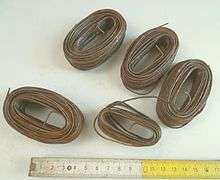
Rebar cages are fabricated either on or off the project site commonly with the help of hydraulic benders and shears. However, for small or custom work a tool known as a Hickey, or hand rebar bender, is sufficient. The rebars are placed by steel fixers "rodbusters" or concrete reinforcing ironworkers, with bar supports and concrete or plastic rebar spacers separating the rebar from the concrete formwork to establish concrete cover and ensure that proper embedment is achieved. The rebars in the cages are connected either by spot welding, tying steel wire, sometimes using an electric rebar tier, or with mechanical connections. For tying epoxy coated or galvanised rebars, epoxy coated or galvanized wire is normally used.
Stirrups
Stirrups form the outer part of a rebar cage. Stirrups are usually rectangular, and are placed at regular intervals along a column or beam to prevent shear failure.[14]
Welding
The American Welding Society (AWS) D 1.4 sets out the practices for welding rebar in the U.S. Without special consideration the only rebar that is ready to weld is W grade (Low-alloy — A706). Rebar that is not produced to the ASTM A706 specification is generally not suitable for welding without calculating the "carbon-equivalent". Material with a carbon-equivalent of less than 0.55 can be welded. (AWS D1.4)
ASTM A 616 & ASTM A 617 reinforcing are re-rolled rail steel & re-rolled rail axle steel with uncontrolled chemistry, phosphorus & carbon content. These materials are not common.
Rebar cages are normally tied together with wire, although spot welding of cages has been the norm in Europe for many years, and is becoming more common in the US. High strength steels for prestressed concrete may absolutely not be welded.
Mechanical connections
Also known as "mechanical couplers" or "mechanical splices", mechanical connections are used to connect reinforcing bars together. Mechanical couplers are an effective means to reduce rebar congestion in highly reinforced areas for cast-in-place concrete construction. These couplers are also used in precast concrete construction at the joints between members.
The structural performance criteria for mechanical connections varies between countries, codes, and industries. As a minimum requirement, codes typically specify that the rebar to splice connection meets or exceeds 125% of the specified yield strength of the rebar. More stringent criteria also requires the development of the specified ultimate strength of the rebar. As an example, ACI 318 specifies either Type 1 (125% Fy) or Type 2 (125% Fy and 100% Fu) performance criteria.[15]
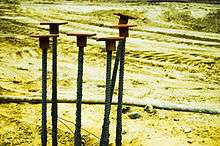
For concrete structures designed with ductility in mind, it is recommended that the mechanical connections are also capable of failing in a ductile manner, typically known in the reinforcing steel industry as achieving "bar-break". As an example, Caltrans specifies a required mode of failure (i.e., "necking of the bar").[16]
Safety
To prevent injury, the protruding ends of steel rebar are often bent over or covered with special steel-reinforced plastic "plate" caps. "Mushroom" caps may provide protection from scratches and other minor injuries, but provide little to no protection from impalement.
Designations
Reinforcement is usually tabulated in a "reinforcement schedule" on construction drawings. This eliminates ambiguity in the notations used around the world. The following list provides examples of the notations used in the architectural, engineering, and construction industry.
| Designation | Explanation |
|---|---|
| HD-16-300, T&B, EW | High strength (500 MPa) 16 mm diameter rebars spaced at 300 mm centers (center-to-center distance) on both the top and bottom face and in each way as well (i.e., longitudinal and transverse). |
| 3-D12 | Three mild strength (300 MPa) 12 mm diameter rebars |
| R8 Stirrups @ 225 MAX | D grade (300 MPa) smooth bar stirrups, spaced at 225 mm centres. By default in New Zealand practice all stirrups are normally interpreted as being full, closed, loops. This is a detailing requirement for concrete ductility in seismic zones; If a single strand of stirrup with a hook at each end was required, this would typically be both specified and illustrated. |
| Designation | Explanation |
|---|---|
| #4 @ 12 OC, T&B, EW | Number 4 rebars spaced 12 inches on center (center-to-center distance) on both the top and bottom faces and in each way as well, i.e. longitudinal and transverse. |
| (3) #4 | Three number 4 rebars (usually used when the rebar perpendicular to the detail) |
| #3 ties @ 9 OC, (2) per set | Number 3 rebars used as stirrups, spaced at 9 inches on center. Each set consists of two ties, which is usually illustrated. |
| #7 @ 12" EW, EF | Number 7 rebar spaced 12 inches apart, placed in each direction (each way) and on each face. |
Reuse and recycling

In China and many other countries, after the demolition of a building, workers are called in to remove the rebar. They scour the site, extracting the metal using bolt cutters, welding equipment, sledgehammers, and other tools. The metal is partially straightened, bundled and sold. This practice is extremely detrimental to the structural safety of subsequent buildings as steel that has been in the plastic yield zone exhibits a less ductile failure mechanism. This results in buildings that are much less safe in earthquake or wind load situations - these buildings collapse suddenly instead of using the steel reinforcing bar to absorb energy and "sway", warning occupants of hazardous conditions and allowing them time to escape.
Rebar, like almost all metal products, can be recycled as scrap. It is usually combined with other steel products, melted down, and re-formed.
See also
References
- ↑ Merritt, Frederic S., M. Kent Loftin and Jonathan T. Ricketts, Standard Handbook for Civil Engineers, Fourth Edition, McGraw-Hill Book Company, 1995, p. 8.17
- ↑ "Le donjon de Vincennes livre son histoire".
- ↑ The office of the first Russian oligarch (Russian)
- ↑ "Coefficients of Linear Thermal Expansion". The Engineering ToolBox. Retrieved 2015-07-06.
- ↑ "GFRP Bar Transverse Coefficient of Thermal Expansion Effects on Concrete Cover" (PDF). Retrieved 2012-08-24.
- ↑ Recommended Field Handling of Expoy-Coated Reinforcing Bars, Concrete Reinforcing Steel Institute
- ↑ Ramniceanu, Andrei Parameters Governing the Corrosion Protection Efficiency of Fusion-Bonded Epoxy Coatings on Reinforcing Steel, Virginia Transportation Research Council, January 2008
- ↑ Epoxy Interest Group. "Epoxy Interest Group of CRSI". Epoxy Interest Group of CRSI. Retrieved 24 August 2012.
- ↑ Wang, Chu-Kia; Salmon, Charles; Pincheira, Jose (2007). Reinforced Concrete Design. Hoboken, NJ: John Wiley & Sons. p. 20. ISBN 978-0-471-26286-2.
- ↑ Threaded Rebar Bolts
- ↑ "BS EN 10080: Steel for the reinforcement of concrete. Weldable reinforcing steel. General.", pp. 19 (2005).
- ↑ Noville, J.F. (June 2015). TEMPCORE, the most convenient process to produce low cost high strength rebars from 8 to 75 mm (PDF). 2nd ESTAD - METEC. Düsseldorf.
- ↑ "BS EN 10080: Steel for the reinforcement of concrete. Weldable reinforcing steel. General.", clause 6.4, pp. 13 (2005).
- ↑ Jesse (January 29, 2013). "Reinforced Concrete Beam Design: Concrete Beam Stirrups? What are they and why are they important?". Retrieved 2015-02-04.
- ↑ ACI committee 318 (2014). ACI 318-14 Building Code Requirements for Structural Concrete and Commentary. American Concrete Institute (ACI). ISBN 978-0870319303.
- ↑ California Dept. of Transportation. "METHOD OF TESTS FOR MECHANICAL AND WELDED REINFORCING STEEL SPLICES" (PDF). Caltrans. Retrieved Feb 2011.
External links
| Wikimedia Commons has media related to Rebar. |
| ||||||||||||||||||||||||||||||||||